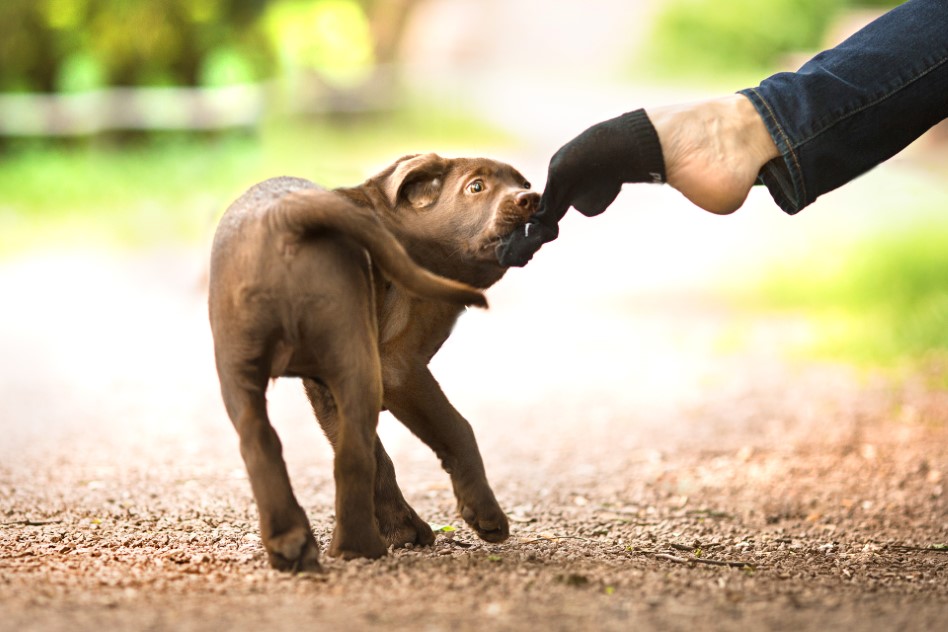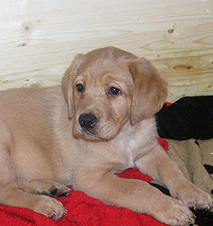An autism assistance dog is a specially trained dog who accompanies children and adults on the autism spectrum. An autism assistance dog is more than a therapy dog, who only encourages development through its presence and the friendship it provides. An autism assistance dog takes on the role of therapy dog and assistance dog at the same time. As a therapy dog, it can help to improve motor skills and vocabulary, create a connection and develop contacts. As an assistance dog, an autism assistance dog actively takes on duties which guarantee security. Autism assistance dogs are not to be confused with the introduction of dogs into animal therapy. While dogs are used in animal therapy in development programs for autistic children, and encourage the development of motor skills, speaking capabilities, stress reduction and contact with others, autism assistance dogs are trained assistance dogs, who help an individual sufferer of autism with the various tasks they have been taught.
In 1996 the first autism assistance dog in Canada was trained. Autism assistance dogs have begun to be trained in Germany in the last few years. Autism assistance dogs can be trained in professional assisted training or sole professional training.
Autism assistance dogs have a special place among assistance dogs. Normally an assistance dog always works for one person - the person with the disability.
Assistance dog - person with the disability
While a child in a wheelchair is the main caregiver for their dog and has to give the assistance dog commands, such as "bring pen" or "light", an autism assistance dog has more than one caregiver. An autism assistance dog is part of a group of three:
Mother/ father - child with autism - autism assistance dog
When an autism assistance dog is for a child, the parents play a significant role. They take complete responsibility for the dog and the dog itself develops a connection with all the family members, and helps the parents as well as the autistic child. An autism assistance dog first goes through basic training and learns the proper behavior and standards for an assistance dog. After roughly a year, training begins for the tasks that will be helpful for the individual autism assistance dog.
- Tasks of an autism assistance dog
- Preventing the child from running away in public The dog is connected to the child with a special autism assistance dog leash. As soon as the child tries to run away and pulls on the leash, the autism assistance dog sits down and its weight prevents the child from running away. The dog enables the parents to get to their child quickly.
- Warning of the child running away at home An autism assistance dog alerts that the child is leaving the home through any of the doors or windows by sounding a bell or an alarm button, or by barking. This allows the parents to react quickly.
- Preventing the child from running away at home The dog can also learn to block the exit when the child tries to leave the house without permission.
- Looking for the child An autism assistance dog can learn to look for the child if they run out of the home unnoticed. The dog usually finds the child within a few minutes, because it knows immediately which direction the child has gone in, and roughly where they have stopped.
- Alerting the parents when the child runs away at night An autism assistance dog lets the parents know when the child leaves their room at night. Because of this, many parents can have their first good night's sleep in a long time, safe in the knowledge that their child can no longer get up unnoticed in the night.
- Safety on the street An autism assistance dog learns to stop reliably at every crossing, and only to cross the street if no cars or bikes are approaching. This is especially helpful when parents or children don't notice a danger on the road.
- Calming the child down during over-stimulation and interrupting meltdowns and stereotypical behavior. An autism assistance dog can learn to interrupt meltdowns and stereotypical behavior by lying with its body across the legs of the autistic child. Through its proximity, the dog also helps to calm down the child when suffering from over-stimulation.
- Shielding in public An autism assistance dog learns to shield the autism sufferer from those in proximity when in public, for example in a line at the checkout while shopping.
- Warning of obstacles If an autistic child has difficulties processing visual stimuli, an autism assistance dog can learn to warn of such obstacles.
- Warning of noises It can be helpful for autistic adults if the autism assistance dog warns of noises in the home. When there is an inundation of noise, and they can't react quickly enough to the noise of the telephone or the doorbell bell, an autism assistance dog can guide them to the noise.
- Minimize rushedness If the autism sufferer is going too fast when walking, the dog can learn to reduce its own speed and thereby remind its partner that they should walk more slowly.
- Warn of epileptic seizures Some sufferers of autism also have epileptic seizures. The dog can learn to give warnings of these, and to go to the parents to get help.
- Scientific studies
Over the course of the last ten years, various studies on autism assistance dogs have been carried out, and they have all shown that autism assistance dogs have a positive effect on children! While studies in the last decade have focused on the role of dogs in animal therapy for autistic children, researchers at the Tufts University School of Veterinary Medicine in the USA carried out a study in 2004, which was the first in the world to focus directly on autism assistance dogs. 22 families took part in the study. All of their children had received an assistance dog from the organization "National Education for Assistance Dog Service". Included in the study were several children with autism. 88% of the families reported a significant improvement in the social and cognitive abilities of the children.
In 2008 there followed a study at the Ontario Veterinary College in Canada, which looked at the effect of autism assistance dogs on children's development. Ten families with autistic children and an autism assistance dog were interviewed for the study. All the families reported improvements in various areas: security of the children at home and in public, motor skills, social interaction within the family, contact with other people, improvement in levels of anxiety and reduction in meltdowns when the dog is nearby, improvement in the emotional needs of the parents.
The University of Montréal in Canada carried out a study in 2010 with 42 autism assistance dogs, who were trained by the MIRA Foundation and lived with families with children between three and fourteen years of age. They researched the effect of the autism assistance dogs on the stress of the children by measuring the cortisol levels of the children. They measured the cortisol levels when the autism assistance dog was with the child, as well as cortisol levels when the child was not with the autism assistance dog. They found out that the cortisol levels were lower when the dog was present, leading to the conclusion that autism assistance dogs can reduce stress. Parents also reported fewer attacks of anger and increased tolerance for noises when the dog was close by.
In the same year, researchers in Ireland looked at the effects of autism assistance dogs on family life. Seven families, who had received an autism assistance dog from the Irish Guide Dog Association, were interviewed. All the parents reported that their lives had changed for the better since they had received the autism assistance dog. They also all said that the autism assistance dogs reliably gave a warning and found the child when they were in danger. They concluded from this that an autism assistance dog was more reliable than any type of alarm, safety lock or security camera. The children also had fewer outbursts of anger and meltdowns, were able to sleep better and had less anxiety. Autism assistance dogs thereby allowed for family trips and holidays which had previously been unthinkable. The study also showed each family experienced improvements in public spaces and in traffic, because the autism assistance dog increased the safety of the child.
- Preconditions for having an autism assistance dog
- You and your child should like dogs and enjoy being around them.
- The child should not have an aversion to strong smells, such as the smell that a dog's fur has, nor fear loud noises such as barking or the rushed movements a dog can make.
- Your child should not behave aggressively towards animals









